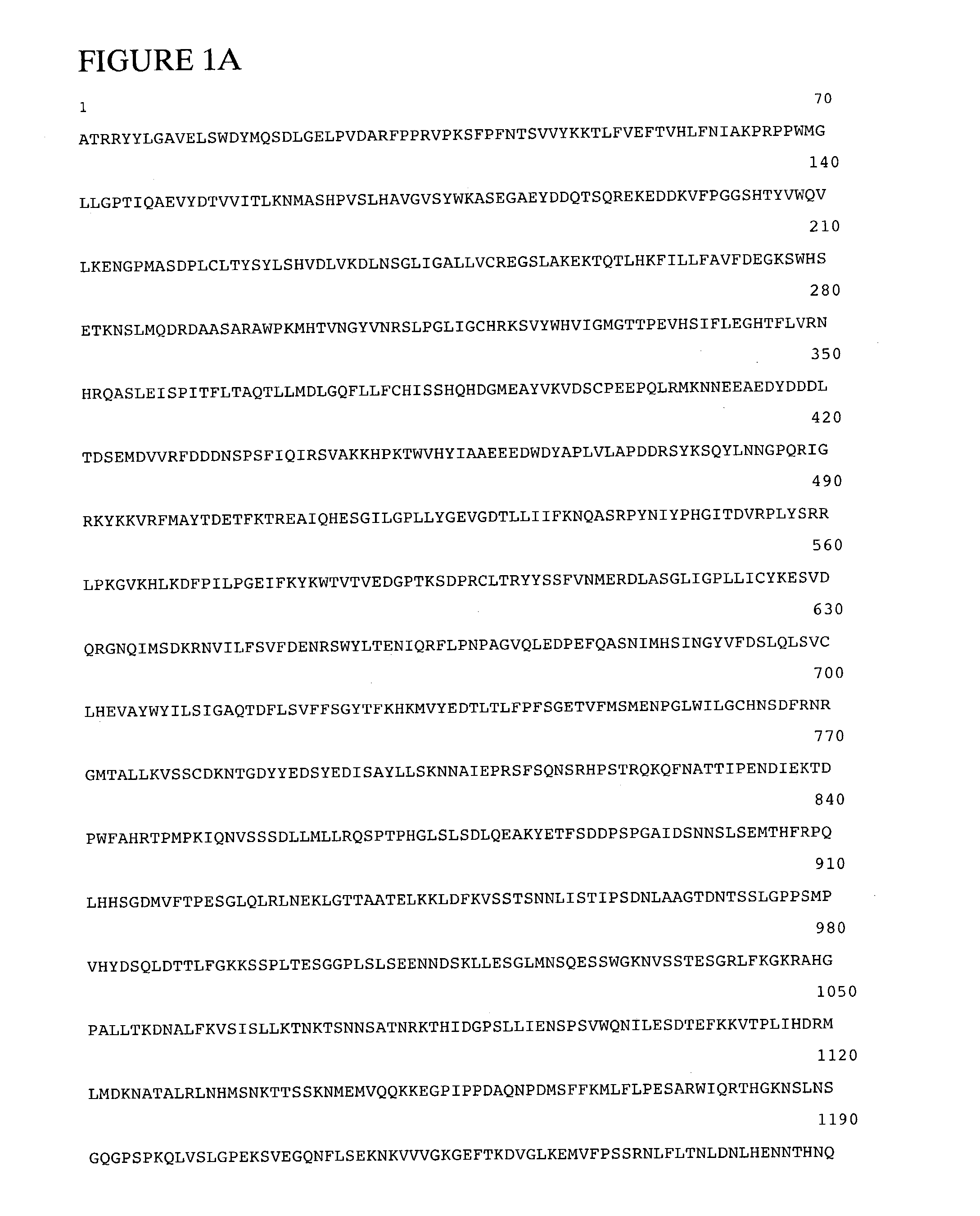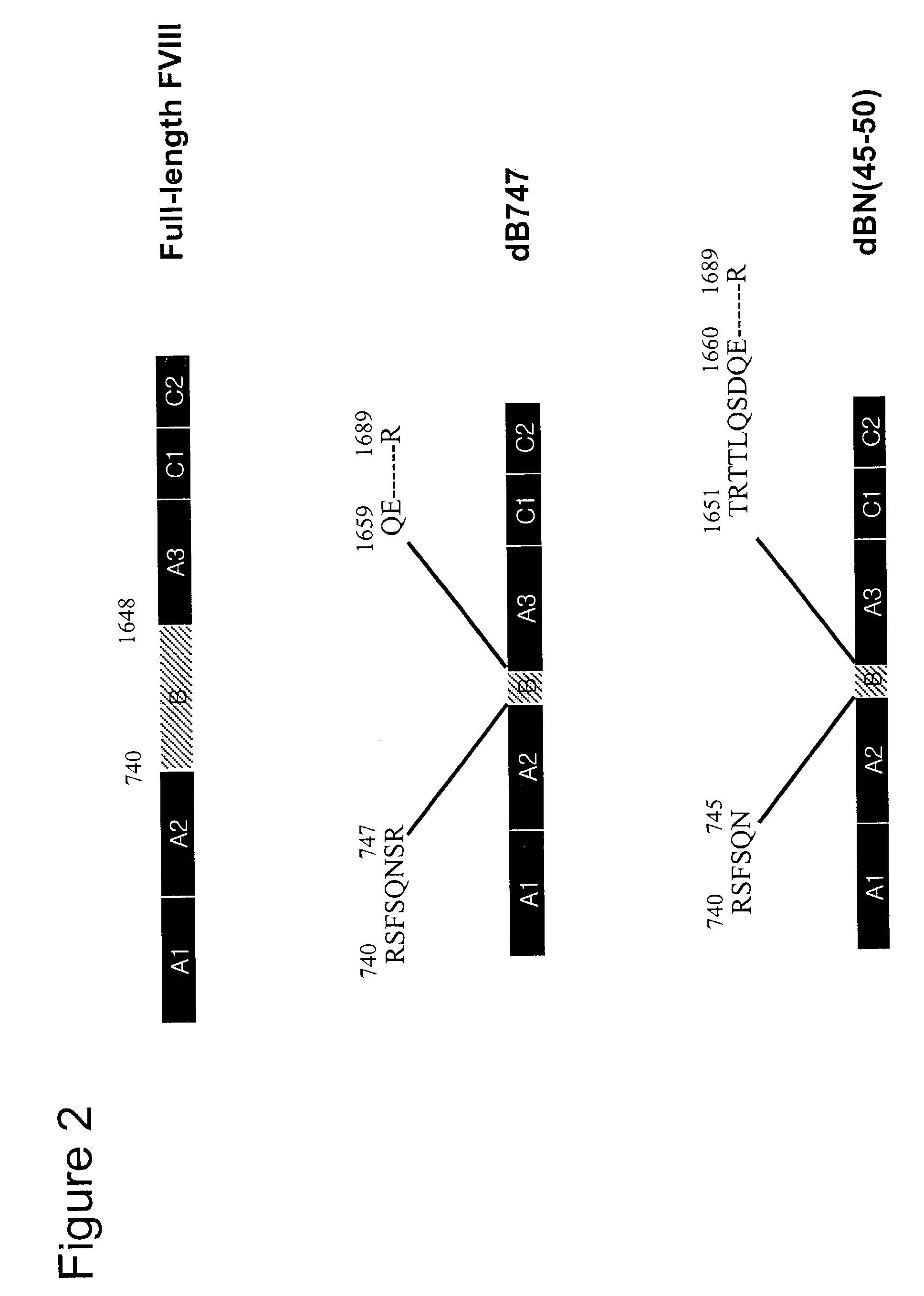Factor VIII polypeptide
a polypeptide and factor vii technology, applied in the field of factor viii polypeptides, can solve the problems of ineffective co-mutation of the two chains, decreased activity of the molecule, and failure of previous strategies, which offer the potential for more efficient manufacturing of recombinant proteins, and achieve stable and efficient expression forms. , the effect of full coagulation activity
- Summary
- Abstract
- Description
- Claims
- Application Information
AI Technical Summary
Benefits of technology
Problems solved by technology
Method used
Image
Examples
example 1
Cloning of Full-length FVIII cDNA
[0140]Reverse transcription was performed using gene specific primer (F8B10, 5′AGCACAAAGGTAGAAGGCAAGC3′ (SEQ ID NO:2)) which covers nucleotides 7237–7258 of published sequence (GenBank accession number: NM 00132). Briefly, 50 ug of human liver mRNA, 1 ul of 10× reverse transcription buffer, 1 μM of F8B10 primer, 4 mM dNTPs, 1 unit of RNAse inhibitor, and 10 units of reverse transcriptase were added in a 9.5 ul total volume reaction mixture. The reaction was then incubated for 90 min at 42° C. Synthesized cDNA was amplified by a standard PCR protocol using pfu polymerase and the three sets of gene-specific primers. The first primer set covers nucleotides 133–1997 of published sequence (GenBank accession number: NM 00132): F8FD (FW, 5′C.CTTTTGCTTCTCCAGTTGAAC3′ (SEQ ID NO:3)) and F8BD (BW, 5′TTCTCTGTGAGGTACCAGCTTC3′ (SEQ ID NO:4)). The second and third set of primers cover nucleotides 1810–4295 and 4044–7320 respectively: F8FC (FW 5′TGCCTGACCCGCTATTACTC...
example 2
Construction of Plasmids Carrying cDNA of the FVIII Derivatives which have Undergone Deletions in the Regions Corresponding to the B and A3 Domains
example 2a
Construction of Plasmids for B-domain Deleted FVIII Derivatives with a Spacer of Various Size Linking the Carboxy-terminus of the Heavy Chain to the Amino Terminus of the Light Chain
[0142]The starting plasmid, pCR2.1-fullFVIII, contains cDNA of full-length Factor VIII, nucleotides 133 to 7320. pCR2.1-fullFVIII was digested with EcoNI to delete nucleotides 2783 to 4804 from the full length FVIII. Cohesive ends of EcoNI-digested vector were blunted by DNA polymerase I Klenow fragment for ligation. This ligated vector was named pCR2.1-deltaEcoNI_FVIII and used as a template for furthermore, precise, deletion mutagenesis.
[0143]Oligonucleotide primers were designed to make a series of precise in-frame deletions. Each primer matches the sequences flanking both sides of the segments to be deleted. Delta-747, delta-754, delta-761, delta-768, delta-775 and delta-782 primers generate the fusion sites of Arg747-Gln1659, Lys754-Gln1659, Ile761-Gln1659, Lys768-Gln1659, His775-Gln1659 and Ile782-...
PUM
| Property | Measurement | Unit |
|---|---|---|
| temperature | aaaaa | aaaaa |
| temperature | aaaaa | aaaaa |
| temperature | aaaaa | aaaaa |
Abstract
Description
Claims
Application Information
 Login to View More
Login to View More - R&D
- Intellectual Property
- Life Sciences
- Materials
- Tech Scout
- Unparalleled Data Quality
- Higher Quality Content
- 60% Fewer Hallucinations
Browse by: Latest US Patents, China's latest patents, Technical Efficacy Thesaurus, Application Domain, Technology Topic, Popular Technical Reports.
© 2025 PatSnap. All rights reserved.Legal|Privacy policy|Modern Slavery Act Transparency Statement|Sitemap|About US| Contact US: help@patsnap.com



